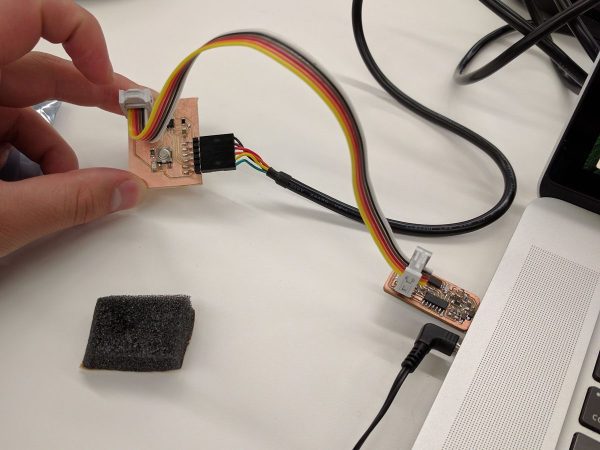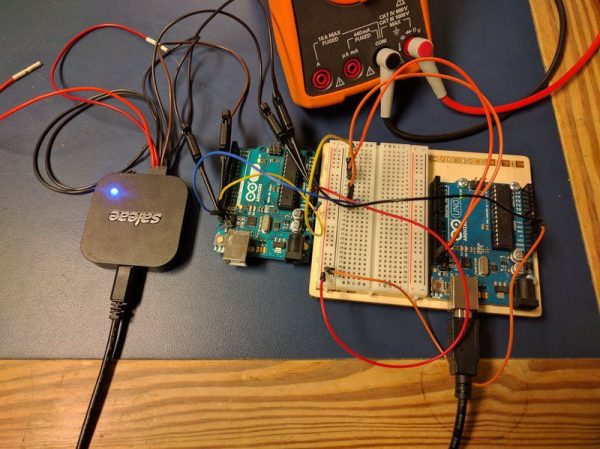Summary of AVR-GCC
This article describes the author's experience transitioning from Arduino IDE and ARM mBed to programming AVR microcontrollers using avr-gcc and Atmel's libraries. The author successfully wrote an LED blink program and focused on implementing I2C communication between two Arduino Uno boards using avr-gcc. Challenges included adapting Atmel Studio libraries for avr-gcc, rewriting interrupt service routines, and debugging I2C code with a logic analyzer. Despite difficulties, the author gained familiarity with low-level AVR programming and Atmel libraries, preparing for a larger final project involving microcontroller communication.
Parts used in the Week 4 Board Programming and I2C Communication Project:
- Week 4 board with AVR microcontroller
- Arduino Uno boards (used as generic ATMega328P targets)
- Breadboard
- Logic analyzer (Saleae model)
- AVR microcontroller (ATmega328P)
- Computer with avr-gcc toolchain and avrdude software
Background
I’ve written dozens of programs using the Arduino IDE and using other tools like the ARM mBed toolchain. My priority for this week was to familiarize myself with avr-gcc and the Atmel libraries.
Week 4 Board Programming
I had already programmed my Week 4 board with the provided serial echoing program so I was pretty comfortable with the flashing workflow. I wrote a very simple AVR GCC program to get the board to blink its LED. This was a good hello world for the libraries and IO structure that the Arduino Bootloader abstracts away (specifically all the registers).
I2c Fun?
Arduino Unos
My final project is relying heavily on using busses like I2c to communicate between microcontrollers. I’ve written several I2c programs using the Arduino toolchain and Wire.h so moving to avr-gcc seemed like the logical next step. I decided to spend the majority of the week getting I2c working between two boards. I’ve already started working on the controller board for the final project, but it wasn’t done and I didn’t have time to mill and stuff a new board.
Luckily, I had a couple Arduino Unos lying around. While complete overkill, they break out the IO nicely and one of them was even attached to a breadboard. I decided to use them for figuring out I2c with avr-gcc since they can be used as a generic ATMega 328P target. Example flashing code for Uno target:
$ avr-gcc -mmcu=atmega328p main.o TWI_Master.o -o main
$ avr-objcopy -O ihex -R .eeprom main main.hex
$ avrdude -F -V -c arduino -p ATMEGA328P -P /dev/ttyACM0 -b 115200 -U flash:w:main.hexavrdude: AVR device initialized and ready to accept instructionsReading | ################################################## | 100% 0.00savrdude: Device signature = 0x1e950f (probably m328p)
avrdude: NOTE: “flash” memory has been specified, an erase cycle will be performed
To disable this feature, specify the -D option.
avrdude: erasing chip
avrdude: reading input file “main.hex”
avrdude: input file main.hex auto detected as Intel Hex
avrdude: writing flash (774 bytes):Writing | ################################################## | 100% 0.14savrdude: 774 bytes of flash writtenavrdude: safemode: Fuses OK (E:00, H:00, L:00)
avrdude done. Thank you.
Atmel’s Libraries
One of the goals was to get used to the new workflow that comes with using the avr-gcc toolchain. While I could have modified an Arduino library or downloaded a drop in “Arduino-like” library, I wanted to use the Atmel application note library (Master, Slave).
However, this caused several immediate problems. These libraries were designed for Atmel Studio which meant several libraries had to be exchanged (ioavr.h –> avr/io.h, inavr.h –> avr/interrupt.h). These avr-libc libraries are not drop-in replacements so I had to rewrite the interrupt service routine (ISR) function declarations and switch out various low-level function (sei () enables interrupts, _NOP() is the no operation instruction, _delay (unit ms) needs to be imported).
After this has been completed, the modified example code compiled. It sent a byte over I2c to the specified slave address, the slave then added one to the data byte, and then asked for the data back from the slave. My modifications mostly served to test the different addresses and learn about Atmel’s library (e.g. turning the LED on for a success).
Debugging
For better or worse, the week was mostly spent debugging the I2c code. After getting the code programmed and hooked up in the identical fashion to my Arduino IDE I2c demo, I wasn’t getting any obvious communication between the two (none of the LEDs lit). I pulled out my Saleae logic analyzer and sure enough there was no signal…
Source: AVR-GCC



